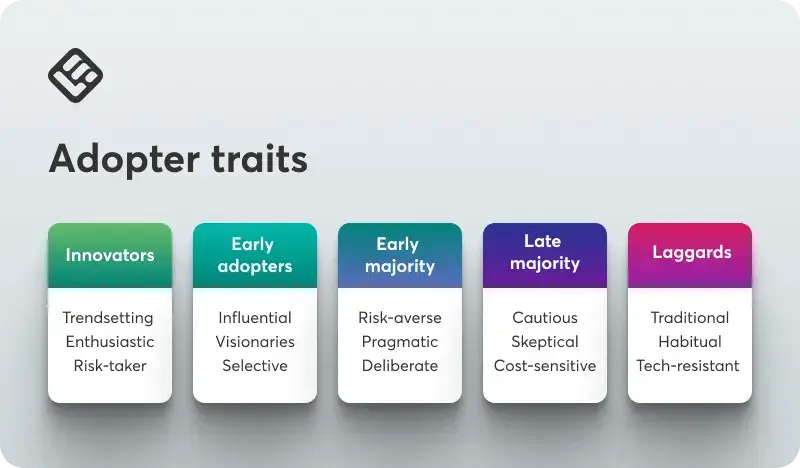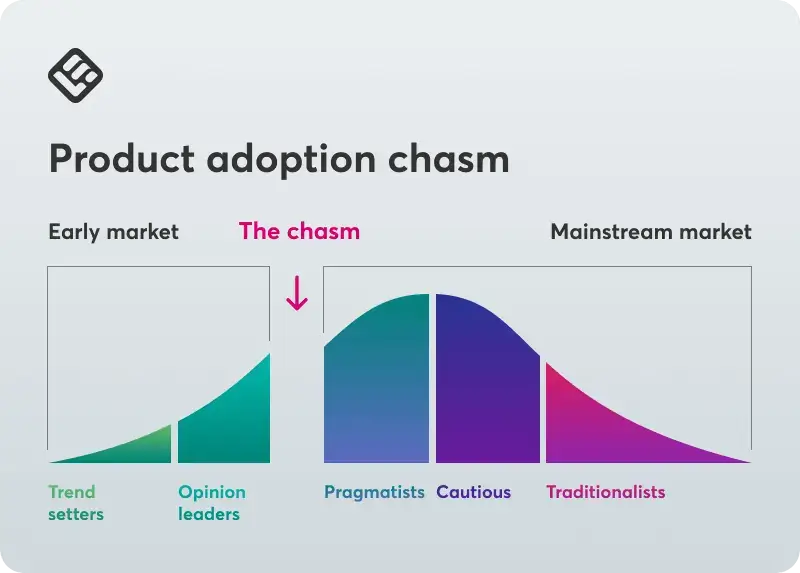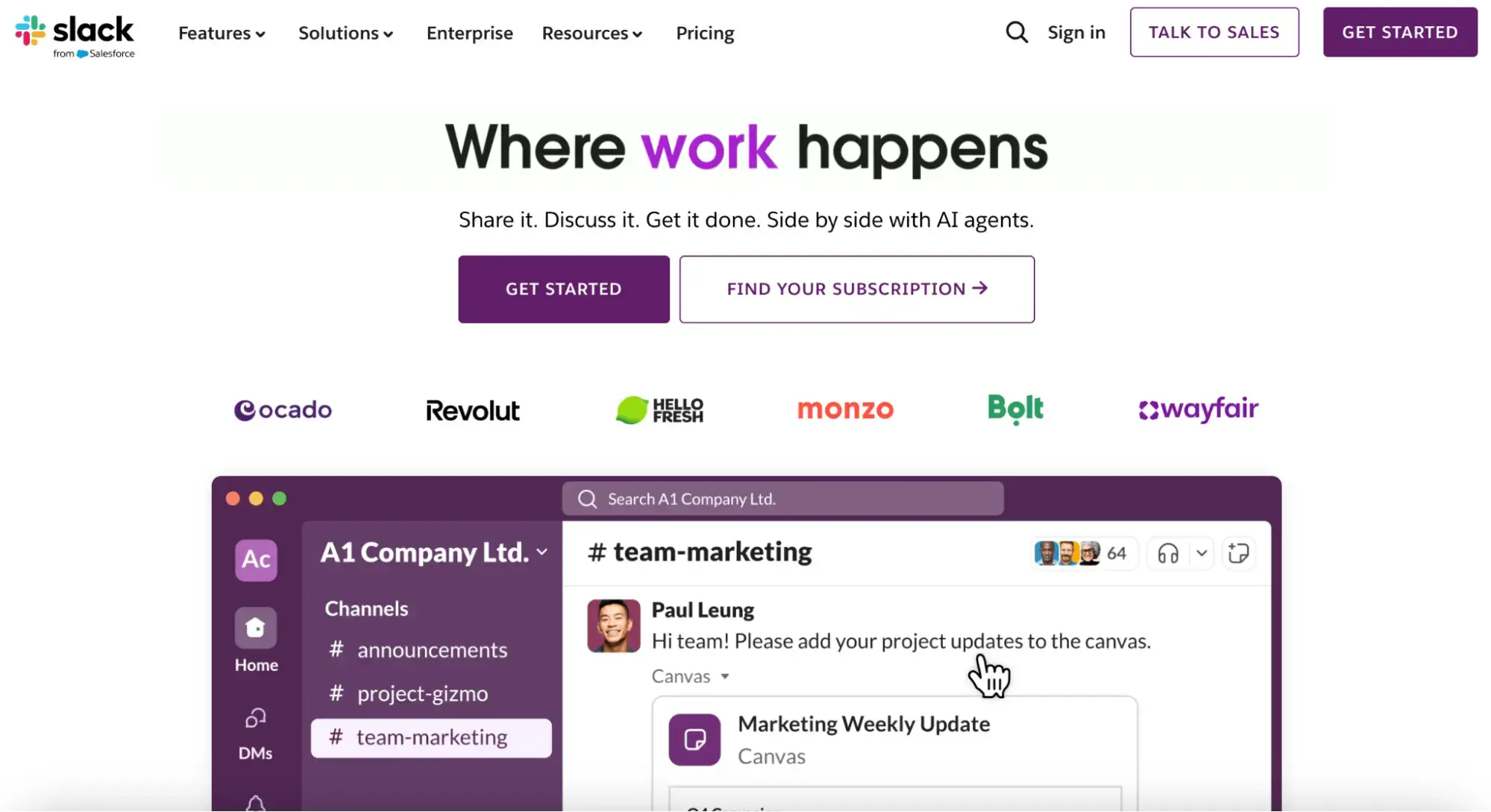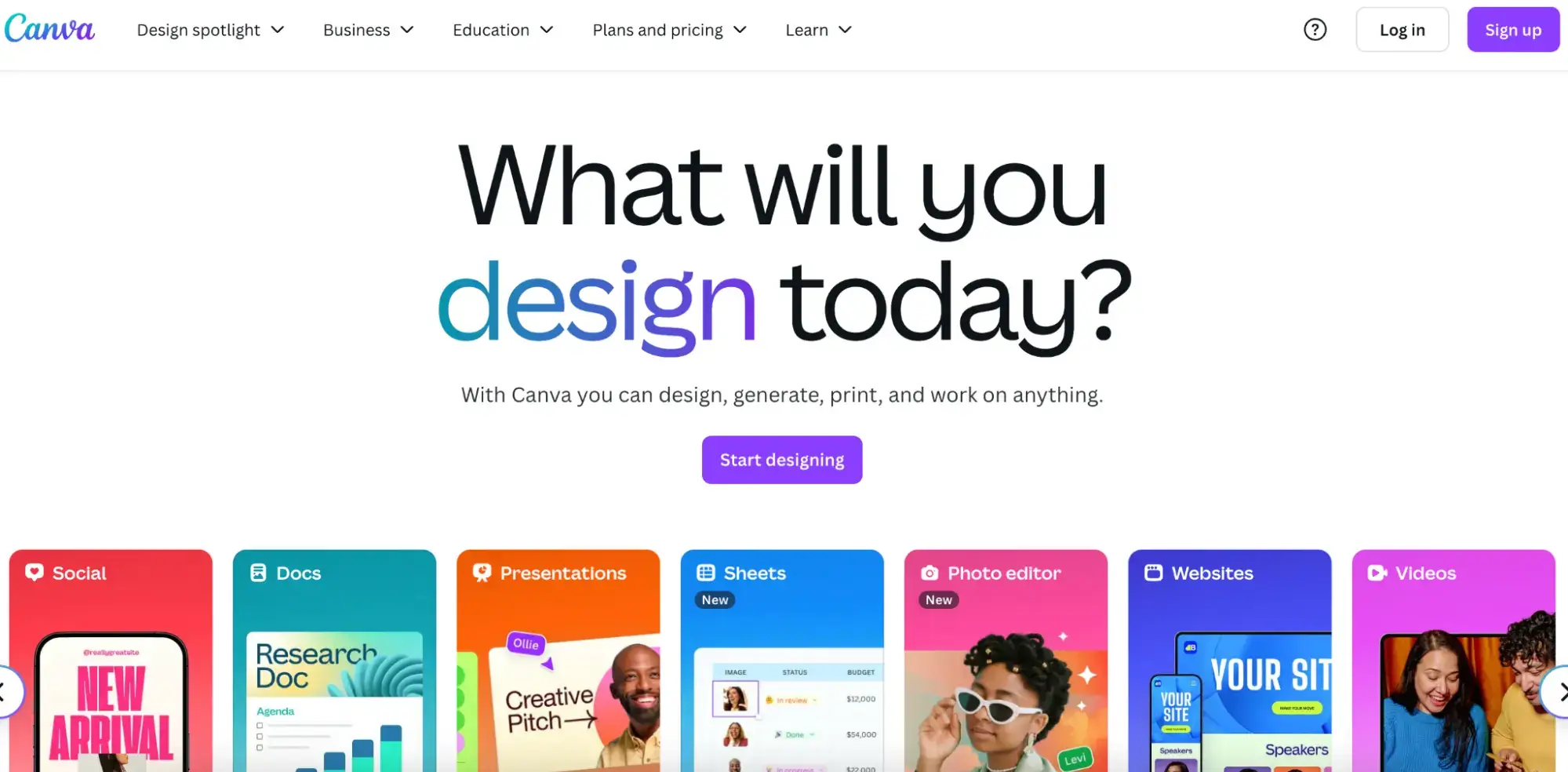Table of Contents
Driving product adoption is one of the biggest challenges SaaS companies face today, but it’s inarguably your number one priority if you want to sustain your business. Getting users to sign up is easy. Getting them to stay, engage, and grow with your product? That needs some thorough planning and strategy.
In this blog post, we break down everything you need to know to build and follow a strong product adoption framework, including:
Why product adoption is essential for SaaS growth
Let’s dive in and map out an effective product adoption strategy from first click to brand advocacy.
What is a product adoption framework?
A product adoption framework is a structured approach to guide users from initial awareness to regular usage and advocacy. Building a strategy around product adoption increases your chances of offering a smooth customer onboarding process that leads to a faster time to value. In SaaS, reducing the time to value is crucial in preventing early churn.
But let’s see more about the importance of product adoption and, therefore, the benefits of adopting a product adoption framework.
Why is product adoption important for SaaS companies?
Getting users to sign up is only half the battle. What truly matters is whether they stick around and use your product regularly. This is how they turn from casual users into loyal customers.
Here’s why product adoption is so critical:
Reduces churn
When users adopt your product and experience real value, they’re far less likely to leave. Product adoption means users have integrated your product into their daily workflows, making churn less likely.
Increases customer lifetime value
The more value users get, the longer they stay. And over time, they’re more likely to upgrade and buy add-ons or other products from your brand. This boosts the total revenue each customer brings in, also known as the customer lifetime value (CLV).
Fosters brand advocacy
Happy, engaged users don’t just stick around—they talk. Satisfied users are more likely to leave reviews, refer colleagues and friends, and promote your product within their networks. More people hear about your product, with less effort and cost on your part. Not a bad deal at all.
Improves product feedback and innovation
Users who engage regularly are the most suitable (and likely) to offer meaningful feedback. Their insights help you build better features, improve UX, and design a product that meets user needs.
Sustains your business
Without strong product adoption, even the best acquisition strategies eventually hit a wall. Long-term business health relies on users not just signing up but actively using and benefiting from your product.
Product adoption isn’t just a metric, but a reflection of how well your SaaS product fits into the lives of your users. And when adoption is strong, everything else becomes easier.
6 stages of product adoption
Product adoption doesn’t happen all at once. Users move through a series of stages, each one shaping their relationship with your product. Understanding this path will help you tailor your messaging and product adoption process to guide users smoothly from first impression to onboarding and loyalty.
Awareness
Users become aware of the product’s existence through marketing, social media, word of mouth, or referrals. This is where interest is sparked, but no commitment has been made.
Best practices:
Interest
Curiosity grows. Users start seeking more information, exploring your website, watching demos, or reading customer success stories. Your value proposition and positioning become crucial here.
Best practices:
Evaluation
Users compare your product to alternatives and consider whether it fits their needs and budget. At this stage, social proof, case studies, and free trials can heavily influence their decision.
Best practices:
Trial
This is the hands-on phase. Users sign up for a trial or freemium version and explore core features. A well-designed onboarding experience is essential to help them reach their first success quickly.
Best practices:
Activation
Users experience the “aha moment.” They complete a key action or workflow that shows the product’s value. This is the tipping point where interest turns into commitment.
Best practices:
Adoption
The product becomes a part of their routine. Users actively rely on it to perform tasks or solve problems, and are likely to continue using it in the long run.
Best practices:
Each of these stages offers a chance to guide, support, and delight your users—so they don’t just try your product, but truly adopt it.
Understanding the product adoption curve
Not all users adopt technology at the same pace. The product adoption curve helps visualize how different user segments embrace new products over time. Knowing where your users fall on the product adoption curve is key to winning them over, enhancing user activation rates, and improving product stickiness for every user.

Innovators
Tech enthusiasts eager to try new products. They love exploring new solutions, even before they’re fully polished and tested.
Tips for engaging this group:
Offer early access or beta programs–they love to be part of product testing and offer early feedback. Highlight how your product is unique and innovative.
Early adopters
Visionaries looking for competitive advantages. They are open to new tools if they see clear strategic benefits.
Tips for engaging this group:
Early adopters are eager but more practical than innovators, so emphasize how your product solves real problems. Use compelling case studies and success stories to prove your point and position yourself as a thought leader to increase trust.
Early majority
Pragmatists seeking proven solutions. The early majority wants to see that your product works and is worth the investment.
Tips for engaging this group:
Provide social proof, testimonials, and product reviews, emphasizing ROI and the product’s ease of use and reliability. Offer guided demos to remove doubts.
Late majority
Conservatives who adopt due to peer pressure. They follow the crowd and need strong reassurance.
Tips for engaging this group:
Offer detailed knowledge bases, tutorials, live demos, and customer training. Double down on customer support. Emphasize simplicity and low-risk implementation.
Laggards
The last group on the product adoption curve are skeptics resistant to change. They adopt only when it’s absolutely necessary or inevitable, often because the product they already use is discontinued.
Tips for engaging this group:
Offer one-to-one support if needed during onboarding and plenty of training resources. Emphasize ease of use and smooth implementation.
💡Mind the chasm

One of the most critical points in the product adoption curve is “the chasm”—the gap between early adopters (visionaries) and the early majority (pragmatists).
Many products fail to make the leap and achieve mainstream success because they fail to meet the needs of more risk-averse users who prioritize stability and ROI over innovation.
How to bridge the chasm
✅ Develop strong use cases
Show how your product solves real-world problems with clear, measurable outcomes.
✅ Invest in social proof
Use testimonials and case studies to build credibility.
✅ Simplify onboarding
Make it easy for new users to get started and reach value quickly.
✅ Build a stable, scalable product
Reliability is more important than novelty, so focus on performance and support.
✅ Market for pragmatists
Update your messaging to highlight practical benefits and ROI instead of novelty.
What strategies can improve user adoption rates? 8 best practices that work
Product adoption is nurtured. The right user adoption strategies can turn new signups into engaged users who stick around, explore more features, and become true advocates.
Here’s how to make that happen:
1. Personalized user onboarding
Reduce churn through onboarding by tailored onboarding flows based on user roles, goals, or use cases. Personalized onboarding shortens time to value and increases engagement right from the start.
Tip: Use data collected during signup or first login to route users through the most relevant onboarding experience. Monitor user behavior to adjust as needed.
2. In-app guidance
This is one of the most crucial elements of a product adoption process. Offer contextual help when and where users need it. Tooltips, demos, and walkthroughs provide real-time support that boosts confidence and reduces drop-offs.
Tip: Trigger tooltips based on user behavior (e.g., hovering or inactivity) to gently guide users without overwhelming them.
3. Feedback loops
Establish two-way communication with users through NPS surveys and quick polls. Listening and acting on feedback makes users feel heard and valued.
Tip: Include a short “Was this helpful?” prompt after key onboarding steps to collect real-time feedback.
4. Feature highlighting
Users won’t use what they can’t find. Highlight underused or new features with in-app banners and push notifications.
Tip: Promote relevant features based on what the user has or hasn’t done.
5. Invest in customer education
Help users become experts in your product by offering structured learning experiences. This reduces support requests and empowers users to get more value over time.
Tip: Use platforms like LearnWorlds to create self-paced courses, product tutorials, or full training academies for onboarding and beyond.
6. Proactive customer success
Don’t wait for users to ask for help. Use data to spot at-risk users and reach out with relevant guidance and check-ins from a CSM before they disengage.
Tip: Automate push notifications and emails based on inactivity or missed milestones. Offer dedicated account managers for high-value plans.
💡 Do not underestimate the role of customer support in product adoption. Cody Jensen, CEO & Founder of Searchbloom explains the importance of support teams very nicely:
Cody Jensen, CEO & Founder, Searchbloom
7. A/B test onboarding flows
What works for one user group might not work for another. Continuously test different onboarding sequences and UI elements to optimize user engagement.
Tip: Start by testing just one variable at a time (like CTA text or step order) to pinpoint what really makes a difference.
8. Add gamification elements
A common SaaS user engagement strategy, gamification makes the adoption journey more engaging and rewarding. By incorporating features like badges and levels, you encourage users to explore and stick with the product.
Tip: Reward users for completing onboarding steps, reaching milestones, or even discovering new features. It’s a great way to keep them going.
How can I measure product adoption effectively? 9 key metrics to monitor
Tracking the right product adoption metrics helps you understand whether the product adoption process works and users are actually finding value and engaging with your product, and not just signing up.
So, is your product adoption strategy working? These 9 metrics will tell.
Activation rate
The percentage of users who reach a meaningful activation milestone (e.g., completing onboarding, creating a first project).
Why it’s important:
It shows whether users are experiencing value early. A low activation rate is often a red flag for onboarding challenges or complex UI.
Time to Value (TTV)
How long it takes for a new user to realize value from your product.
Why it’s important:
Shorter TTV reduces the chance of early drop-off and improves trial conversion rates. It’s a critical indicator of onboarding effectiveness.
Feature adoption
The frequency and breadth of use for key features.
Why it’s important:
It reveals what users find valuable, and which features might need better onboarding or to be simplified (if users discover them but don’t use them), or to be highlighted more (if users do not discover them at all).
Customer retention
Percentage of users continuing to use the product over time.
Why it’s important:
User retention is a signal of user satisfaction and the ultimate proof of product adoption. If users stick around, it means they’re finding value in your product.
Churn rate
The rate at which users stop using your product.
Why it’s important:
High churn hinders growth and signals low user engagement–further investigation is required to find out whether it’s due to poor user experience, budget issues, or something else. It’s a metric every SaaS team watches closely.
Product-qualified leads (PQLs)
Users who demonstrate high intent through product usage (e.g., reaching key thresholds or using premium features).
Why it’s important:
PQLs help align product engagement with sales potential. It’s crucial in product-led growth business models where product usage drives conversion.
Daily/Monthly Active Users (DAA/MAU)
How often users return to the product within a daily or monthly window.
Why it’s important:
This ratio reflects not merely product adoption but also stickiness. A higher ratio suggests users are forming habits around your product.
Customer satisfaction (CSAT)
How satisfied users are with a specific interaction or experience (e.g., after onboarding, support, or feature use).
Why it’s important:
CSAT offers immediate, actionable feedback on key touchpoints. It helps identify friction early and improve the user experience in real time.
Net Promoter Score (NPS)
How likely users are to recommend your product to others, typically rated on a scale of 0–10.
Why it’s important:
NPS is a strong indicator of overall sentiment and loyalty. High NPS correlates with long-term retention, advocacy, and word-of-mouth organic growth.
Tracking these metrics regularly will give you a rounded view of product adoption. With the right data in hand, you can confidently improve the user experience and build an effective product adoption strategy over time.
Tools and technologies for a winning product adoption strategy
Sure, the product adoption process is anything but simple. So much needs to be done: onboard new users, offer continuous support, analyze user behavior, and collect feedback.
Consider the following options, depending on your priorities:
1. Product analytics platforms
Product analytics platforms analyze user behavior and user engagement: which features are the most and least used, how often users return, and where they drop off. With robust event tracking and funnel analysis, product analytics platforms help you identify what’s working and what’s not for all your customer segments.
Use for:
Top tools to explore:
Mixpanel, Amplitude, Heap, PostHog
2. Customer feedback and NPS tools
While analytics show what users are doing, feedback tools reveal why. Net Promoter Score (NPS), customer satisfaction surveys, and open-ended feedback offer valuable insights into the user experience and overall happiness across the customer journey. Encourage users to share their feedback by establishing continuous feedback loops through in-app messaging and pop-up surveys.
Use for:
Top tools to explore:
Delighted, Qualtrics, Hotjar (for surveys), Typeform, UserVoice
3. Customer support and helpdesk tools
Support interactions are a goldmine for uncovering blockers to product adoption. Helpdesk platforms track user challenges and the types of issues they face, how often they occur, and how quickly they’re resolved, and use these to improve both your product and customer success.
Use for:
Top tools to explore:
Zendesk, Intercom, Freshdesk, Help Scout
4. Product adoption software
Most SaaS companies use product adoption software to streamline their onboarding process and offer support in real time without interrupting the in-app experience. User onboarding platforms support product adoption and boost user engagement by helping new users get value faster.
Use for:
Top tools to explore:
Appcues, Userpilot, Whatfix
5. Customer education platforms
Customer education platforms offer deeper education through structured online courses. Among the key features of customer training platforms are assessment engines and learning analytics, which help gauge user understanding of your product and training effectiveness and make data driven decisions regarding your programs.
Use for:
Top tools to explore:
LearnWorlds, Docebo, Thought Industries
👉LearnWorlds is a top-rated customer training platform that offers rich learning features, deep analytics, an AI assistant, and advanced tools for managing your online academy. Try it now with a 30-day free trial.
6. Community and communication platforms
Sometimes the best insights (and support) come from users themselves. Community platforms encourage peer learning and feedback sharing through online discussions and live events. Not only that, they’re also a great tool to strengthen brand loyalty.
Use for:
Top tools to explore:
Slack (private communities), Discord, Circle, Zoom, Bevy
💡Explore more solutions in our blog post 5 top product adoption software platforms to boost user engagement.
Case studies and real-world examples
Here are some real-world examples of successful product adoption by well-known companies, each illustrating a unique approach to engaging users and driving long-term usage.
Slack

Slack’s explosive adoption wasn’t just about product-market fit—it was about how easy it was to get started and bring others along. They offered a frictionless onboarding experience with minimal setup and strong in-app guidance. Crucially, Slack built viral loops into its core: as one team member joined, they naturally invited others to collaborate.
Key adoption drivers:
Canva

Canva made design accessible to non-designers by offering an intuitive interface and onboarding paths tailored to different user types (e.g., marketers, educators, students). They focused on helping users get quick wins—like completing their first design in minutes.
Key adoption drivers:
Next steps
A product adoption framework gives structure to your strategy and clarity to your execution. It helps you move beyond guesswork and build experiences that turn new users into loyal customers.
Take a moment to reflect: Is your current product adoption journey intentional, data-driven, and scalable?
If you’re looking to improve your onboarding and customer education experience, LearnWorlds offers a powerful all-in-one platform to create engaging training academies, track progress, and boost long-term adoption.

Androniki Koumadoraki
Androniki is a Content Writer at LearnWorlds sharing Instructional Design and marketing tips. With solid experience in B2B writing and technical translation, she is passionate about learning and spreading knowledge. She is also an aspiring yogi, a book nerd, and a talented transponster.




